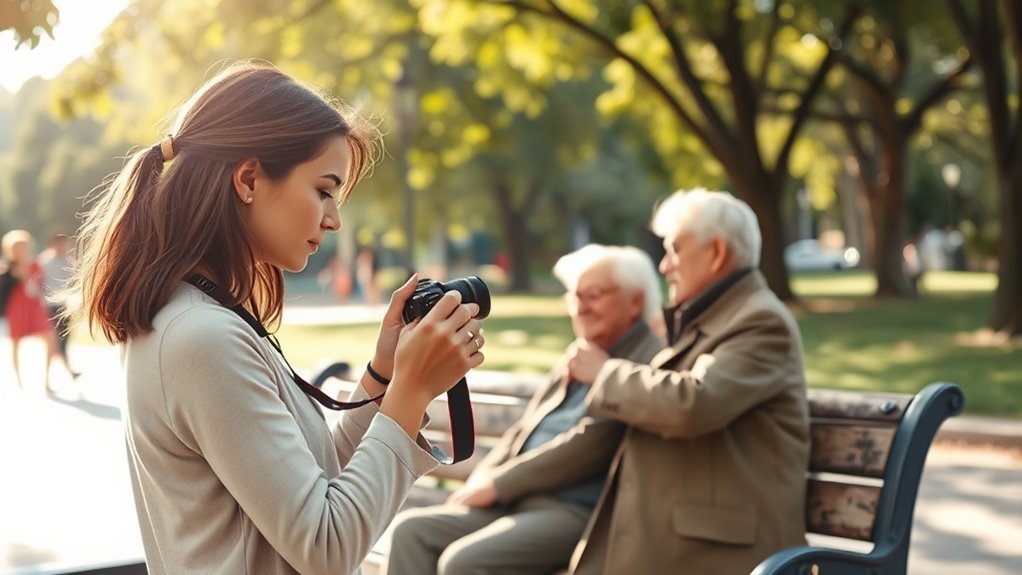When capturing moments, always respect people’s privacy by asking for permission, especially for close-up shots or vulnerable individuals. Be mindful of your surroundings—avoid blocking views or causing disruptions—and follow posted rules at locations like museums or private spaces. Keep noise down, turn off flash when needed, and be environment-conscious. Sharing images responsibly means considering how they might affect others. If you want tips on mastering respectful photography, keep exploring this essential etiquette.
Key Takeaways
- Always ask for permission before photographing individuals, especially in personal or sensitive situations.
- Be mindful of your surroundings, avoiding disruptions or blocking views in crowded or quiet places.
- Respect environmental and cultural norms by turning off flash and avoiding disturbance of wildlife or sacred sites.
- Follow posted rules and seek authorization when photographing in restricted or private locations.
- Share images responsibly, ensuring you have consent and considering the privacy and dignity of subjects.

Ever wondered how to capture stunning photos without upsetting others? Photography is a powerful way to preserve memories and share moments, but it’s essential to do so with respect for those around you. Respecting people’s privacy and comfort is the cornerstone of good photography etiquette. Before clicking away, always consider whether your subject is comfortable with being photographed. If you’re in a public place, ask for permission if you plan to take close-up shots of individuals or groups, especially children or vulnerable populations. Even in busy settings, a simple smile and a polite inquiry can go a long way toward maintaining goodwill. People often appreciate the courtesy, and it prevents awkward or uncomfortable situations later.
Another key aspect is being aware of your surroundings. Look around to see if your photography might interfere with others’ activities or cause inconvenience. For example, snapping photos at a crowded event without paying attention can block someone’s view or distract them. Keep a respectful distance and avoid intruding on personal space. If you’re in a location where photography is restricted—like certain museums, religious sites, or private property—make sure to adhere to posted rules. Ignoring these can not only offend but also lead to legal issues. If you’re unsure, it’s respectful to ask staff or authorities beforehand.
Lighting and noise are also important considerations. When photographing in quiet or solemn places, such as memorials or places of worship, keep noise levels down and avoid disruptive behavior. Using flash can be disruptive or damaging in some environments, so switch it off unless necessary. In outdoor settings, be mindful of the environment—don’t trample on delicate plants or disturb wildlife just to get the perfect shot. Respect nature’s boundaries and leave no trace of your visit. Additionally, understanding financial management principles can help you budget for equipment or travel expenses related to photography adventures, ensuring you stay within your means.
Lastly, consider the impact your photos might have once they’re shared. Avoid posting images that could embarrass or harm someone, especially without their consent. Be cautious about taking or sharing images of people in vulnerable situations, as it can violate their privacy or dignity. Remember, photography is about capturing moments, not exploiting them. By being considerate and respectful, you not only improve your own experience but also foster a positive environment for others to enjoy photography too. Following these simple etiquette principles ensures everyone can appreciate the beauty around them without feeling uncomfortable or disrespected.
Frequently Asked Questions
Is It Okay to Photograph People Without Their Permission?
No, it’s generally not okay to photograph people without their permission, especially in private or sensitive settings. You should always ask for consent first, showing respect for their privacy. If someone declines, respect their decision and avoid taking their picture. In public, it’s more acceptable, but being polite and considerate still matters. Remember, respecting others’ boundaries creates a more positive and respectful photography experience for everyone.
How Should I Handle Photographing Sensitive or Private Moments?
When photographing sensitive or private moments, you should always approach with respect and discretion. If possible, ask for permission beforehand, explaining why you want to take the photo. If the moment is too delicate or urgent, consider whether capturing it is appropriate. Avoid intrusive angles or flash, and be mindful of the emotional state of those involved. Prioritize their privacy and comfort above capturing the shot.
What Are the Legal Restrictions on Drone Photography?
Imagine soaring above a bustling park, but before capturing the scene, you need to know the rules. Legally, you can’t fly drones near airports, over crowds, or private property without permission. Many countries have restrictions on altitude and line-of-sight. You must also respect privacy laws, avoiding filming individuals without consent. Always check local regulations, register your drone if required, and fly responsibly to stay within legal bounds and avoid penalties.
Can I Take Photos in Restricted or Private Areas?
No, you shouldn’t take photos in restricted or private areas without permission. Doing so can lead to legal trouble, privacy violations, or damage to relationships. Always respect signs, barriers, and property rights. If you’re unsure whether you’re allowed to photograph somewhere, ask for permission first. Respecting boundaries shows consideration and helps you avoid potential legal or ethical issues while capturing your moments responsibly.
How Do I Deal With Confrontations Over Photography?
When confrontations happen over photography, stay calm and respectful. Politely explain your intent and listen to their concerns. If they ask you to stop, comply without argument. Keep your tone friendly, and avoid escalating the situation. If needed, apologize and move away. Remember, respecting others’ boundaries is key. Staying composed and courteous helps resolve conflicts peacefully and shows you value their comfort and privacy.
Conclusion
By following these photography etiquette tips, you become a guardian of memories rather than a thief of moments. Remember, every shot you take is a brushstroke on someone’s story—approach with respect and kindness. When you honor others’ privacy and feelings, you turn fleeting images into lasting bonds. So, next time you lift your camera, ask yourself: are you capturing a moment, or stealing a piece of someone’s world? Respect turns snapshots into shared memories.










